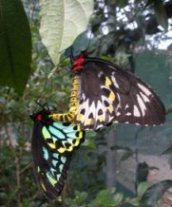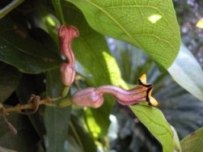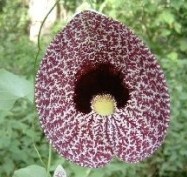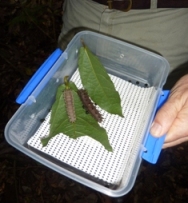Richmond birdwing butterfly
Rescuing the beautiful Richmond birdwing butterfly
Collaboration between governments, conservation and community groups are helping the Richmond birdwing butterfly make a colourful comeback.

Fast facts
Common name: Richmond birdwing butterfly
Scientific name: Ornithoptera richmondia
Family: Papilionidae (swallowtails)
Status: Vulnerable
Habitat: Subtropical rainforests that support native birdwing butterfly vines, Pararistolochia praevenosa at lower elevations (below 600m) and Pararistolochia laheyana at higher elevations (above 600m).
Species overview
The spectacular Richmond birdwing butterfly is the largest sub-tropical butterfly in Australia and is native to the rainforests of southeast Queensland and northeast New South Wales.
In the Yugambeh language of south-east Queensland, Jalngay Ngahriyan is the name given to the Richmond birdwing butterfly. Jalngay comes from light or bright, and Ngahriyan means dancing or playing, with the combination meaning dancing lights.
Once found from Grafton in New South Wales to Maryborough in Queensland, Richmond birdwing butterfly populations declined in the early 1900s due to habitat loss and fragmentation. They are now only known to occur regularly in two areas:
- north of Brisbane from Caboolture to Cootharaba on the Sunshine Coast
- from Wardell, in northeast New South Wales, to Ormeau and Mount Tamborine in the Gold Coast hinterland.
Ecology and behaviour
The Richmond birdwing butterfly plays a role in the ecosystem as a pollinator, aiding in the reproduction of various plant species and contributing to the overall biodiversity of its habitat.
This species is in flight from September to April in coastal areas and November to February in coastal ranges. Adults fly throughout the day but are more active during the early morning and late afternoon.
The Richmond birdwing butterfly lays round, yellow eggs singly or in small clusters on one of their two native larval food vines, depending on the location and elevation. The larvae (caterpillars) are dependent on these vines for food. Mature larvae can grow up to 70mm long and are variable in colour, from black to brownish grey. They have a series of prominent, fleshy spines running along their upper body.

Characteristics
The Richmond birdwing butterfly has:
- a wingspan of up to 16cm for females and 13cm for males
- a green stripe on the dorsal thorax (between the head and abdomen) for males
- a distinctive red patch on its body at the base of the wing, visible from below (males and females)
- a black upper forewing with a distinctive iridescent green leading edge. The upper hindwing is predominantly iridescent green with black spots (males)
- dark brown or black wings with extensive white, cream or, in the hindwing, yellowish markings (females).
Threats
- Habitat loss and fragmentation
- Sub-population isolation and inbreeding
- Introduced plants, especially the toxic Dutchman’s pipe (Aristolochia elegans)
- Climate change, particularly droughts and high temperatures.
What’s being done?
- Between 2008 and 2018, we conducted a captive-breeding and release program. This aimed to restore wild populations by mating butterflies from different locations to produce more genetically diverse offspring and distributing them to select sites.
- During the program, about 500 individuals, mainly larvae and pupae, were introduced to 11 sites across south-east Queensland. There is evidence that natural breeding has occurred at the release sites, bolstering local sub-populations, and resulting in more adult butterflies in the wild.
- We’re working with a range of partners to help conserve the Richmond birdwing butterfly through planting of the lowland larval host plant, removal of Dutchman’s pipe vine, mapping of the current distribution of the Richmond birdwing butterfly and its larval host plants.
- Queensland’s national parks and protected areas play an important role in protecting threatened species. As part of the Queensland Protected Area Strategy 2020–2030, we’re acquiring more land to expand our protected area system and help conserve critical species habitat.
Who is helping?
- Richmond Birdwing Conservation Network (Wildlife Preservation Society of Queensland)
The Network delivers a range of ongoing activities including mapping the current distribution of the butterfly and its food plant; removing introduced Dutchman’s pipe vines; creating flagship corridors by planting vines; and running hands-on school projects.
In 2023, CWCN received Queensland Government funding to support the Bringing Back the Richmond Birdwing Butterfly to Brisbane's Inner West project.
Since 2018, Seqwater has been removing Dutchman’s pipe plants and replacing them with Richmond birdwing larval host vines in the Hinze Dam catchment of the Gold Coast.

The butterfly is also attracted to lay on the introduced Dutchman’s pipe (Aristolochia elegans)which is a common introduced plant in many gardens and some areas of bushland. However, the leaves of this invasive vine are toxic and kill the larvae when eaten.

How you can help
- Join the Richmond Birdwing Conservation Network
- Join one of the citizen science projects aimed at Richmond birdwing butterfly recovery
- If your property falls within the butterfly’s habitat: plant birdwing butterfly food vines and remove the invasive Dutchman’s pipe
- Donate your birdwing vine fruit (seed pods)
- Report sightings of the butterfly and vines to help map their distribution at Atlas of Living Australia.
- Make a donation to support our work to protect and recover the Richmond birdwing butterfly.
- Find out more about how you can help support threatened species efforts.